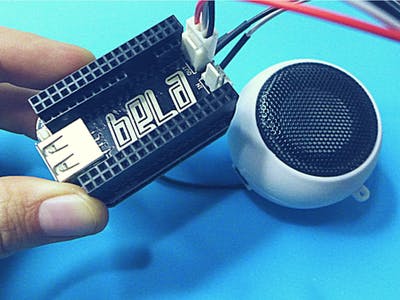Categories: Beginner
Setting up the Bela Mini is so easy, I did it live! 😉
Seriously, the documentation is really smooth; I just wanted to have a quick reference here on Hackster.
1. Software
Flash SD card
Grab the latest Bela image here:
https://github.com/BelaPlatform/bela-image-builder/releases
Support for Bela Mini has been included since version 3.4, and it boots just fine as soon as you plug it in.
I used
Etcher
to burn the image to a MicroSD card. You need one with at least 8GB.
Prepare your machine
Follow the instructions for your PC to install the driver; this allows your browser to talk to the Beagle over USB:
https://github.com/BelaPlatform/Bela/wiki/Getting-started-with-Bela#software-setup
2. Hardware
At some point while all that is downloading/flashing/rebooting/etc., pick up your soldering iron and solder the Bela Mini’s pins to the PocketBeagle. That’s right – you solder them directly together! There are 72 pins to solder, but you can take it easy during the software setup.
There should be paper instructions in the box that show you how to do this without ruining everything forever. In short:
- Bela goes on top, with Beagle also facing up;
- Line up the USB ports;
- Leave about 5mm of separation between the two boards (with only a little bit poking out through the Beagle).
Plug in the "IN" and "OUT" audio cables. Ready to rock!
3. Fire it up!
Plug the Beagle’s Micro USB port into your computer. (The Bela Mini’s USB A port is a host port, meaning that you can use it to plug in peripherals like a keyboard!)
If you see little happy blinky blue LEDs, all is well! Otherwise, check out the
troubleshooting docs
.
Then, direct your computer’s browser to 192.168.7.2 – this is how you access the IDE and everything else on the Beagle/Bela! It took my Mac a minute to actually pull that up, but you should soon see the IDE come up.
The default example that comes up produces a sine wave at 440 Hz (A4). Test your perfect pitch by trying to whistle it before you push the "Run" button at the bottom of the screen 🙂 It’s shaped like a round arrow. Hit the square "Stop" button to stop it. Expand the right sidebar and explore!
There are a bunch of built-in examples, but I also recommend
this GitHub repo
by my Bela hero, Becky Stewart.


Comments are not currently available for this post.